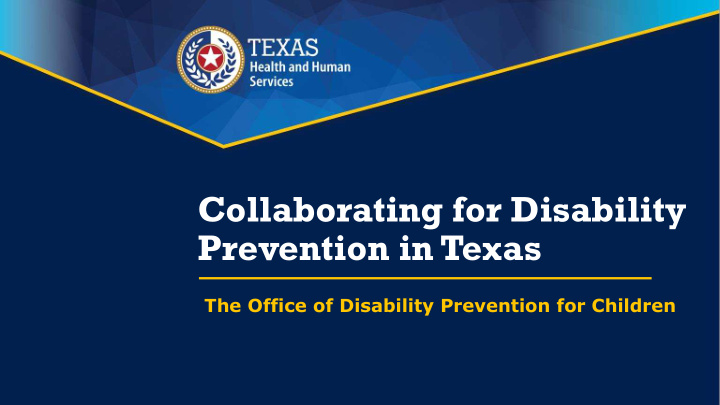



Collaborating for Disability Prevention in Texas The Office of Disability Prevention for Children
Background • Successor to the former Texas Office for the Prevention of Developmental Disabilities • Senate Bill 200 abolished the former office and its executive committee and transferred the duties to HHSC effective Sept. 1, 2017 • The Office of Disability Prevention for Children was created in response to this legislatively mandated transfer to ensure the prevention of developmental disabilities remains a focus in Texas
Purpose and Goals ODPC strives to: • Prevent developmental disabilities in children ages 0-12 • Includes disabilities that manifest in utero and during birth • Minimize the losses caused by preventable disabilities • Coordinate a unified, comprehensive prevention effort in Texas
Developmental Disability A severe, chronic disability that is: • A mental or physical impairment, or both • Manifested before a person reaches the age of 22 • Likely to continue indefinitely And results in: • Substantial limitations in three or more major life activities • A need for a combination and sequence of special interdisciplinary or generic care, treatment, or other lifelong or extended services
Duties The Office shall: • Educate the public • Promote sound public policy • Identify, collect, and disseminate information and data • Work with appropriate divisions within the commission, state agencies, and other entities to develop a plan to monitor and reduce the incidence or severity of developmental disabilities
Duties (cont.) The Office shall: • Promote and facilitate delivery of needed prevention services • Develop, operate, and monitor programs addressing the prevention of developmental disabilities • Monitor and assess the effectiveness of the commission and state agencies in preventing developmental disabilities
Duties (cont.) The Office shall: • Recommend the role the commission and each state agency should have • Facilitate coordination of state agency prevention services and activities • Encourage cooperative, comprehensive, and complementary planning among public, private, and volunteer individuals and organizations
Levels of Prevention Primary prevention • Prevent the onset of disability, aims to reduce the incidence of disability Secondary prevention • Detecting the disability in its earliest stages and intervening to slow or stop its progression Tertiary prevention • Interventions to stop or slow the progression of a disability to mitigate its negative consequences and prevents secondary conditions
Current Activities • Quarterly stakeholder meetings • Next meeting: Feb. 26, 2018 at 10:00am to 12:00pm in the Brown Heatly Public Hearing Rooms • Identify areas of focus • Environmental scan • Collect data on selected developmental disabilities of focus • Identify and assess prevention efforts within HHS, and other state agencies • Identify areas for improvement and make recommendations
Partners within HHS Programs we plan to work with include: • Early Childhood Intervention • Special Supplemental Nutrition Program for Women, Infants and Children • Prevention and Early Intervention • Healthy Texas Women and Family Planning Program • Office of Acquired Brain Injury • Intellectual and Developmental Disabilities and Behavioral Health Services
How can you help? • Meet with us to discuss shared interests • Join us for our quarterly stakeholder meetings • Recommend connections with other individuals or programs • Let your partners know we are here
Thank you odpc@hhsc.state.tx.us (512) 462-6392 https://hhs.texas.gov/about-hhs/process- improvement/office-disability-prevention-children
Recommend
More recommend